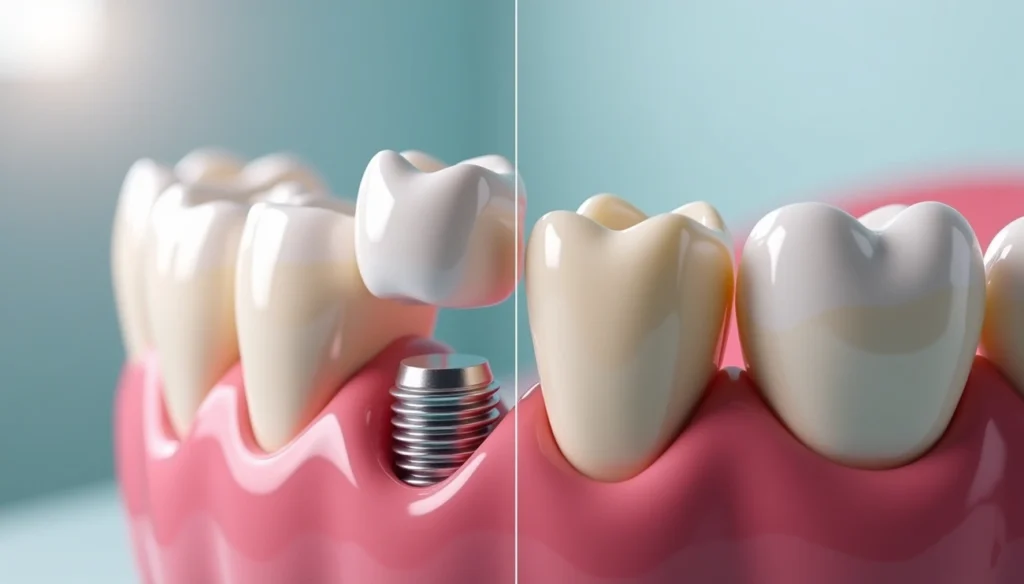Dental implants have become the gold standard to replace missing teeth. About 3 million Americans now have dental implants, and this number grows by 500,000 each year. These permanent tooth replacements have an impressive success rate of over 90%. They give patients a reliable alternative to removable dentures or dental bridges.
The complete implant process usually takes six to nine months. Some patients might need up to a year to finish the whole ordeal. Dental implants replace broken, rotten, or missing teeth through small titanium posts that doctors surgically place into the jawbone. This trip needs careful planning, professional execution, and strong commitment to oral health. The results justify the time and money invested since dental implants can last throughout a patient’s life.
This piece explains each phase of the dental implant procedure. Patients can learn what happens from their original consultation through the final crown placement. Understanding these steps helps prepare for this life-changing dental restoration process.
Understanding Dental Implants and Their Purpose
Image Source: Dental Partners of Boston
Anyone thinking about getting dental implants should know their purpose and structure. These implants are not temporary fixes – they create a permanent base for artificial teeth that work just like natural ones.
What is a dental implant?
A dental implant acts as an artificial tooth root, usually made from titanium or ceramic materials that work well with human tissue. The complete system has three main parts: a threaded post that goes into the jawbone, an abutment (connector piece) that extends past the gums, and a restoration (crown, bridge, or denture) that replaces the visible part of the missing tooth.
The implant post naturally fuses with the jawbone through a process called osseointegration. This creates a stable foundation that can handle daily use for decades. The integration helps implants work like natural teeth and stops bone loss that usually happens after tooth removal.
Why implants are preferred over bridges or dentures
Dental implants have clear advantages over other tooth replacement options. They don’t need healthy teeth to be ground down for support, unlike bridges. On top of that, implants have a remarkable 97% success rate over 10 years. Bridges typically need replacement after 5-10 years.
Implants are more stable and comfortable than removable dentures. Regular dentures can move around and make clicking sounds that embarrass people. They can also cause bone loss over time. Implants let you chew almost as well as natural teeth, while standard dentures only give back 30-40% of your bite strength.
Who is a good candidate for implants?
The best candidates have good overall health, enough jawbone density, and healthy gums. Adult patients of any age can get implants if they have adequate bone structure.
Some health conditions might affect your eligibility. These include uncontrolled diabetes, blood clotting disorders, active cancer treatment, or metabolic bone disease. Heavy smoking can also slow down healing and fusion with bone, which might cause implant failure.
A dental professional needs to fully evaluate your oral health and medical condition to see if implants are right for you.
Step-by-Step Breakdown of the Dental Implant Procedure
Image Source: Dentfix Turkey
Your trip to getting a fully working dental implant involves several key phases that happen over months. Each stage needs precision and patience for the best results.
1. Initial consultation and oral evaluation
A detailed evaluation starts your dental implant process. Your dentist will get into your oral health, take detailed X-rays or CT scans to check bone density, and review your medical history. This full picture helps decide if you qualify for implants and shows what work needs to be done before implantation.
2. Tooth extraction (if needed)
Your damaged tooth might need removal before implant placement. Modern extraction techniques preserve surrounding bone and tissue to create an ideal foundation for future implants. The site usually needs several weeks to heal properly.
3. Bone grafting and healing period
Your jawbone might lack enough density to support an implant, making bone grafting essential. This procedure adds bone material from your body, a donor, synthetic sources, or animal-derived material to strengthen the implant site. Healing starts within a week, but complete integration needs at least three months. Larger grafts might need 9-12 months to heal fully.
4. Implant placement surgery
Your dentist makes an incision in your gum tissue to expose the bone after preparing the surgical site. They create a precise opening for the titanium implant post with specialized instruments. The implant needs careful positioning to achieve primary stability—a key factor for successful integration.
5. Osseointegration and healing time
Bone cells attach directly to the titanium surface after implant placement through osseointegration. This biological fusion creates a stable foundation and usually takes 3-6 months. The bond between bone and implant grows stronger during the first 12 weeks.
6. Abutment and crown placement
An abutment connects to the implant once osseointegration finishes. Your dentist takes impressions to create a custom crown that matches your natural teeth. The final crown needs careful adjustment to line up with your bite before permanent attachment to the abutment.
What to Expect During Recovery and Healing
Image Source: International Clinics
Your dental implant surgery’s success depends on proper recovery. The body starts its natural healing process, and patients feel different levels of discomfort during this time.
Managing pain and swelling
The first 24-48 hours after surgery typically bring mild to moderate pain. You can get relief from over-the-counter medications like ibuprofen (Advil) or acetaminophen (Tylenol) every six to eight hours. Start taking pain medication before the anesthetic wears off to stay comfortable. A cold compress on your cheek near the surgical site for 15-20 minutes helps reduce swelling and numbs the area. Pain usually decreases each day. Call your dentist right away if your symptoms get worse instead of better.
Foods to eat and avoid
Your body’s healing after dental implants depends on good nutrition. Cool liquids and very soft foods work best in the first 24-48 hours:
- Recommended options: Smoothies (without using straws), yogurt, applesauce, mashed potatoes, scrambled eggs, and nutritious soups
- Foods to avoid: Hot foods and beverages, crunchy items, sticky foods, and alcohol
Foods rich in calcium and vitamin D support bone health and healing. You can start eating firmer foods as comfort allows, usually after 7-10 days.
Oral hygiene during recovery
Clean teeth properly to prevent infection without disturbing the surgical site. Rinse with warm salt water 2-3 times daily after the first 24 hours. Use a soft-bristled toothbrush and brush carefully without putting direct pressure on the implant site. Your dentist might give you an antiseptic mouthwash that reduces bacteria and helps healing. Stay away from rinses containing alcohol early on since they can irritate healing tissues.
Signs of complications to watch for
Reach out to your dentist if you notice ongoing pain beyond normal healing, heavy bleeding, more swelling after 72 hours, fever, unusual discharge, or a loose implant. These signs might point to an infection or implant failure that needs quick attention.
Long-Term Care and Follow-Up After Implants
Image Source: Dentaprime UK
Your dental implant’s lifespan depends a lot on proper maintenance. Research shows that patients who get regular maintenance checks face peri-implantitis only 18% of the time. This number jumps to 44% among those who skip professional care.
Routine dental checkups
Schedule regular checkups at the time of your original implant placement – every 3-4 months during the first year. After that, twice-yearly visits are enough unless you notice issues. Your dentist checks soft tissues, plaque buildup, probing depths, and takes X-rays to track bone health during these visits. X-ray schedules start 6-8 months after loading the implant and continue every 3 years with stable conditions.
How to clean around implants
Daily cleaning needs specific tools to work well. An implant-specific interdental brush helps clean those tough spots. A water flosser with antimicrobial solution works great among other tools. Studies prove that oral irrigators with chlorhexidine fight peri-implant mucositis better than plain water. Use a soft-bristled toothbrush and non-abrasive toothpaste gently to protect implant surfaces.
When to replace crowns or components
Your implant might last forever, but the crown usually needs replacement every 15-20 years. Look out for loose fittings, pain, receding gums, or visible damage. Tell your dentist about these signs quickly to avoid bigger issues.
Conclusion
Dental implants showcase modern dentistry’s remarkable progress by offering patients a permanent solution that mimics natural teeth. The six-month to one-year trip involves several carefully arranged stages that ensure optimal integration and functionality. Each step from the original consultation through final crown placement builds on the previous one and creates a foundation for lasting oral health.
These titanium anchors’ high success rate proves their reliability. Proper care makes them almost identical to natural teeth in both function and appearance. Patients who follow post-surgical instructions and maintain excellent oral hygiene can enjoy their implants without issues for decades.
Implants solve the biggest problem of bone preservation, unlike temporary options such as dentures or bridges. This benefit alone makes them worth thinking over despite the longer treatment timeline. The osseointegration process needs patience but creates stability that other tooth replacement options cannot match.
Most patients find the recovery process manageable with discomfort that fades quickly. Following dietary restrictions and oral hygiene protocols during healing improves outcomes by a lot. On top of that, regular professional maintenance visits reduce the risk of complications like peri-implantitis.
Dental implants ended up offering more than just tooth replacement – they bring back confidence and quality of life. Patients get back almost complete chewing function without worrying about slippage or discomfort. This change makes the step-by-step dental implant procedure one of the best investments in long-term oral health.
FAQs
Q1. How long does the entire dental implant process typically take? The complete dental implant procedure usually takes between 6 to 9 months, though in some cases it can extend up to a year. This timeline includes initial consultation, any necessary preparatory procedures, implant placement, healing periods, and final crown attachment.
Q2. What are the main advantages of dental implants over other tooth replacement options? Dental implants offer several benefits: they function like natural teeth, preserve jawbone health, don’t require altering adjacent teeth, have a high long-term success rate, and can last a lifetime with proper care. They also provide better stability and comfort compared to dentures.
Q3. Who is considered a good candidate for dental implants? Ideal candidates for dental implants are adults with good overall health, sufficient jawbone density, and healthy gum tissue. There’s no upper age limit, but certain conditions like uncontrolled diabetes, blood disorders, or heavy smoking may affect candidacy.
Q4. What should I expect during the recovery period after implant surgery? During recovery, you may experience mild to moderate pain and swelling for the first few days. It’s important to follow a soft food diet initially, maintain careful oral hygiene, and watch for any signs of complications. Most patients can return to normal activities within a week.
Q5. How do I care for my dental implants long-term? Long-term care for dental implants involves regular dental check-ups (initially every 3-4 months, then semi-annually), proper daily cleaning with specialized tools like interdental brushes and water flossers, and prompt reporting of any issues like looseness or discomfort. With proper care, implants can last a lifetime, though the crown may need replacement after 15-20 years.


